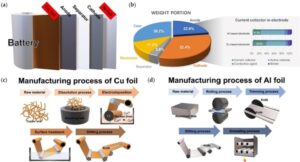Compared with conventional metallic current collectors, a plastic film–based technology can reduce battery fires by more than 90%.
At a Glance
- Soteria consortium develops vapor deposition plastic film technology to enhance safety of EV Li-ion batteries
- Innovative non-plastic separator technology with high thermal stability also available
- Consortium approach allows industry-wide access to patent pool of safety technologies
Lithium-ion (Li-ion) battery fires may be rare, but when they do happen the combustion is ferocious. Battery OEMs and automakers alike, therefore, have vested interests in doing whatever is possible to engineer safety into their designs.
One organization at the forefront of technology that enhances battery safety is the Greenville, SC–headquartered Soteria Big Consortium, which has developed alternatives to conventional metallic aluminum and copper foil current collector materials. In fact, its plastic film–based solution reportedly can reduce the occurrence of battery fires caused by damage, abuse, or manufacturing defects by more than 90%.
Soteria Global Consortium Vice President Amy Brinson will present a case study illustrating the group’s achievements in developing innovative safety solutions at FabBatt, the newest addition to Advanced Design & Manufacturing Expo (ADM) coming to Montréal on Nov. 13 and 14, 2024. Brinson is scheduled to speak on Thursday, Nov. 14, at 2 p.m. in the Tech Theatre/Théâtre technique.
Vapor deposition plastic film
Produced via physical vapor deposition, the aluminum and copper metallized films burn out like a fuse around an internal short, isolating it and allowing a cell to continue functioning after damage, as demonstrated in the video below. Furthermore, the current collectors remove roughly 80% of the metal of a traditional foil, increasing gravimetric and volumetric energy density. Less metal in the battery also reduces weight by 15 to 20%.
There is potential for several different substrate materials, according to Brinson. “BOPET is certainly one of the most common, as it is readily available and presents the safety feature of burning away under the intense currents that can be generated from an internal short inside a cell. PP, PEN, and polyimides have also shown promise as substrates.”

Woven separator works like a dream
Soteria has also developed a separator solution that can replace traditional ultra-high-molecular-weight polyethylene (UHMWPE) porous oriented films used in Li-ion batteries. Dubbed Dreamweaver and based on a nonwoven aramid fiber structure, the technology reportedly further improves safety on account of higher thermal stability, increases the cell charging cycle life, and decreases the battery’s carbon footprint due to fewer CO2 emissions in the production process.
The higher thermal stability is graphically demonstrated in the video embedded below that compares the flammability of UHMWPE, ceramic-coated UHMWPE, and Dreamweaver separators. In addition, 25Ah pouch cells that employed a Dreamweaver separator retained 80% of their capacity at nearly 5,000 cycles, while 18650 cylindrical cells with Dreamweaver separators retained 80% capacity at 1,000 cycles.
100-plus active projects
The Soteria Big Consortium’s roll of members reads like a who’s who of Li-ion battery development:
- DuPont, Teijin, Toray, and Sabic (active in separator and current collector development);
- Asahi Kasei’s Celgard subsidiary, a representative separator film manufacturer;
- end users such as GM, Mercedes-Benz, Daimler Truck, and Motorola Solutions;
- Lenovo and NASA are also participating in R&D efforts.
In total, more than 100 projects are ongoing within the consortium, including commercial cells, pack development, cell prototyping, and device commercialization. Member benefits include access to Soteria IP along with material and cell samples, project opportunities, technical support, and access to a confidential content database. Membership options start at $2000 annually for “kilowatt” access (companies with <$1 billion in annual revenue) and range up to $8000 for “gigawatt” access (companies with >$1 billion in annual revenue).
Industry-wide accessibility
Soteria CEO and co-founder Brian Morin, who developed the company’s technology, decided to opt for a consortium approach to commercialize the technology as he concluded that the lithium-ion battery industry will not accept a sole supplier of an important material [such as a current collector]. “Ultimately, it is our goal to ensure that safety technologies are broadly accessible. Additionally, we believe that the consortium promotes a more open dialogue around battery safety,” notes Brinson.
“For the separator, paper manufacturers act as Soteria licensees and cell builders may purchase the material as they would with any supplier,” says Brinson. “For the current collector, we license directly to the cell builders and end users, so if they were to take it commercially, it would require licensing.”
Soteria is also developing a patent pool of several safety technologies, which will include the current collector and other devices that can improve battery safety. They will be made available under one global license structure, and any technology that gets added at a later date will be made accessible with no additional licensing fee.

